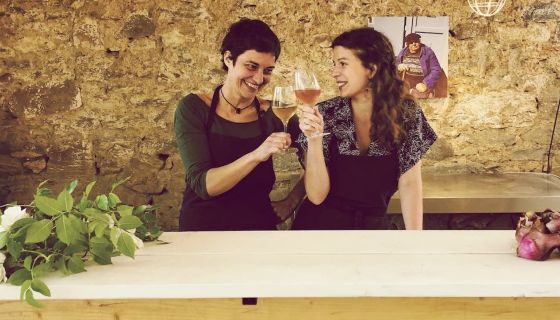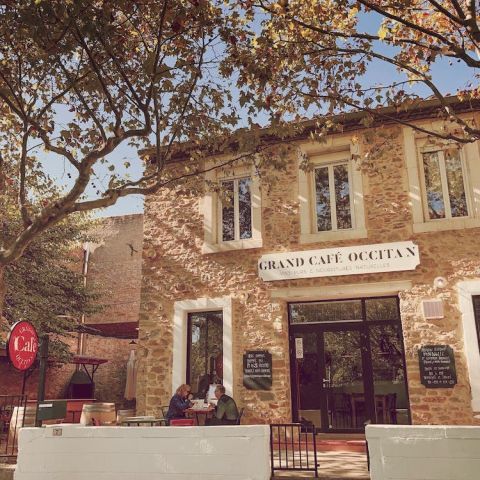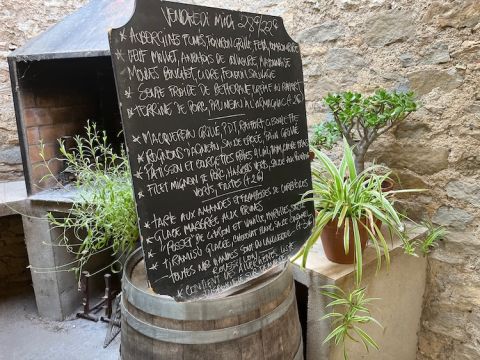As soon as we walked onto the shady terrace of the Grand Café Occitan in Félines-Minervois in the Languedoc this summer we heard the phrase that no restaurant-goer ever wants to hear. ‘I’m afraid this is not possible’ was the response of the restaurant’s manager, Portuguese Ana Dias, who has worked in various London establishments such as Anchor & Hope as well as being an important influence at what is described on the cafe's website as the 'très foody Auberge de Chassignolles'. Pictured on the left above, she was presumably keen to protect her talented English chef Tristram Bowden, who was mentored by Fergus Henderson of St John.
This was partly our fault. We were eight and we were meeting a couple of other friends there, which meant a table of 10. But unfortunately a breakdown in communications between ourselves had meant that we had not passed this on and the booking had been made for only eight. As the manager firmly told us, that was two too many for them to accept ordering off the menu. The difference between eight and 10 is not great but she was adamant. There were four other tables booked, all of four people, so there would be 26 in total.
In the end a fudge was arranged. We were seated at a table for 10 but broken down, metaphorically, into two tables of five. We each ordered separately and we were served as two different tables. We paid the bill of €320 for very good food and wine as one and we had a very good time. But the restaurant’s hard-line attitude left its mark. Nobody likes to be told ‘it is not possible’ as soon as they walk in.
(The late Juli Soller once told me that this was the principal reason they decided to close El Bulli in north-east Spain when the restaurant was still in its prime. Such was the demand for tables for the six months when this restaurant was open that they were full from the moment they opened the booking line in January. And, as Soller explained, he had gone into the restaurant business to be in a position to say ‘yes’ to his customers rather than ‘no’.)
But there is a more practical reason why kitchens decide to limit the number that they will serve à la carte, which is determined by the size of the kitchen and most importantly the size of the ‘pass’.
I wrote in detail about what constitutes a pass and its vital importance to every kitchen in December 2007 after I’d spent the morning service with chef Herbert Berger in the extremely busy kitchens of his then restaurant 1 Lombard Street in London.
The pass is the intersection between the kitchen, the chefs, the waiting staff and the orders. It fulfils the essential place for the handover of the food and the final place at which the chef, or sous chef, can inspect the finished plates as they arrive from the distinct sections of the kitchen and give them final approval.
It is the physical size of the pass that will determine the number of customers the kitchen feels comfortable serving à la carte. The pass can be anything horizontal and solid but it tends to be relatively small and neither as big in size as the different sections of the kitchen behind the pass nor the more lavishly decorated restaurant. But its importance cannot be overestimated.
Another important factor is the physical size of the kitchen and the various sections in it, as James Lee, kitchen consultant at Eximius Projects and a restaurateur (The Hind’s Head in Bray and The Oarsman in Marlow) explained.
‘The size of the kitchen sections is probably the most determining factor: the respective sizes of the larder, the vegetable, the meat, the fish, the sauce and the dessert sections which allow the chefs to prepare enough food. Balthazar in Covent Garden, for instance, serves 1,600 people a day from a service kitchen on the ground floor but this is backed up by a large preparation kitchen in the basement. A linear cook line is the most efficient way to maximise covers as all the chefs are putting up their plates and a chef de pass will assemble the trays and send them. But these require space and investment.’
We ate and drank very well at Grand Café Occitan. From a blackboard menu of five starters, four main courses and four desserts I really liked a dish of oeuf mollet, a soft-boiled egg with anchovies and mayonnaise; excellent lamb kidneys served with a spicy sauce; and a refreshingly thick lemon posset with blueberries. I would happily return, but not with such a large group!
Le Gavroche, London
It would be remiss of me and this website if we were to overlook the sad closure of the emblematic, long-standing two-star Le Gavroche restaurant, which its chef/proprietor Michel Roux Jr announced a fortnight ago and will finally take place in January 2024.
Le Gavroche has been part of our culinary education for as long as I can remember. It was always a very special treat, walking there, being welcomed into the small bar, walking downstairs to the low-ceilinged dining room vastly improved in 2014. Its food has invariably been excellent but so too has been the quality of its outstanding customer care.
It was to Le Gavroche that we took our son, William, for his birthday dinner in September 2012 just months before he became a restaurateur. The occasion was of course celebratory but I wanted him to learn from the best. It seems to have rubbed off.
There are various contributory factors for Roux’s decision to close: Brexit; COVID-19; the disappearance of the long business lunch, which had already forced Le Gavroche to open only in the evenings; as well as the increasing expense of running such a large, people-based business. But its closure also reflects a change in the modus operandi of such restaurants.
Michelin two- and three-star restaurants are inherently not that profitable but flourish as the obvious tip of an iceberg that comprises many other activities such as television, books, personal appearances and, increasingly, branded produce. In May 2021 I asked eight restaurateurs and chefs from around the world to identify who had been their most important employee during the first lockdown. This was Michel Roux Jr’s response.
‘Just before the first lockdown I took on a young office assistant. When COVID-19 struck, I explained that sadly I would have to let him go.
‘He then explained that in the short term he had been with us he had had a vision of what he could bring to the company. He told me that our social media presence was lacklustre and our website was ancient and costly to run. He said that he could design a simple, cost-efficient website and incorporate a shop to sell books and other items with a Le Gavroche logo. During lockdown he got to work and I gradually took him off furlough to the extent that he was soon back full time. The online shop went crazy, boosted by a huge leap in followers on all our social media channels. We now average sales of £18,000 per month with special boxes, wine and other branded items. I feel very lucky to have him.’
There are today more ways of making a brand name such as Le Gavroche popular and profitable other than running a highly labour-intensive kitchen and dining room over two floors on a small ground floor and larger dark basement.
I wish Michel and all his team the very best. They deserve it. We will miss them all but above all I will miss their highly polished ice-cream trolley on wheels which I have secretly coveted for years.
Grand Café Occitan 7 rue de l'Occitanie, 34210 Félines-Minervois, France; tel: +33 (0)4 30 16 62 72
Le Gavroche 43 Upper Brook Street, London W1K 7QR; tel: +44 (0)207 408 0881
















